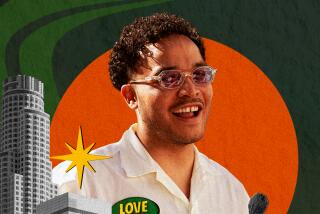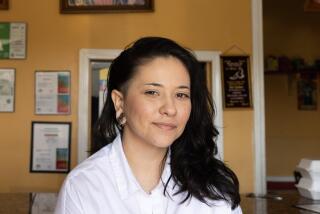One God, two cultures
- Share via
To those who know it only by reputation, the Nickerson Gardens housing project in Watts is a forbidding place, plagued by violence and poverty and ruled by African American gangs.
So naturally, Father Peter Banks brought 200 Latino parishioners there in December for a posada, a Christmas ritual that re-creates Joseph and Mary’s search for a place for Jesus to be born.
Banks, pastor of St. Lawrence of Brindisi Church on Compton Avenue, thought the visit could help burst preconceptions and break down prejudices. His Latino congregants might be surprised to learn that violent crime was down at Nickerson, that gangs were not as pervasive as they once were and that, contrary to stereotype, a majority of the residents are Latinos.
If African American residents turned out in decent numbers, the service would be another small step toward mutual understanding.
The Latino visitors walked briskly through a parking lot and into Nickerson’s gym, some casting nervous glances over their shoulders. Inside, mariachis in black outfits and gold ties tuned their violins. A small group of black community leaders helped prepare champurrado and chicken tostadas.
“The big struggle is the black and the brown. How do we get them together,” Banks said before changing into white robes and leading a prayer service in Spanish. “We can bring them together with music and food.”
The posada drew several hundred people, but they were almost all Latinos, not the integrated crowd Banks had hoped for. Still, he considered the event a small victory.
“This is major, getting some of our parishioners to come to Nickerson, because they don’t go,” he said. “They won’t come here. They’re afraid.”
Banks, 63, a Catholic priest from a tiny Irish village, has become an unlikely force for racial understanding in Watts. Over more than three decades, he has watched as the community changed from predominantly black to predominantly Latino. He’s seen racial tensions lead to segregation within his own congregation.
His efforts to bridge the divide have been marked by humility, patience and modest expectations. He believes the key to reconciliation is not grand projects but a multitude of small gestures. During meals at St. Lawrence, he will ask blacks to serve Latinos and vice versa. Without fanfare, he lends support and cash to people working to curb violence and promote understanding in the neighborhood.
When he realized that African Americans and Latinos shared a passion for gospel music, he made gospel standards a centerpiece of Sunday services.
“He’s able to walk between the raindrops,” said Oscar Neal, 72, owner of Jordan’s Cafe on Wilmington Avenue, a neighborhood gathering place.
In a typical gesture, Banks recently enlisted Michael Wainwright, an African American parishioner, to help recruit black students to St. Lawrence’s elementary school. Then he asked Wainwright, who runs a job services program in Watts, to speak with Latino teenagers about how to find work.
“He’s so concerned about the community. Not only Catholics, but Protestants also. Not only blacks, but Latinos, Asians and everybody,” Wainwright said. “He walks in the developments, all through them: Jordan, Nickerson, Imperial, Gonzac, and he talks to the Spanish people about the importance of getting everyone together. He’s very unifying.”
Banks’ vision is embodied in a mural he commissioned that covers a wall behind the church. It shows scenes from Latino and black civil rights struggles and a diverse group of children surrounding the Virgin of Guadalupe and holding the flags of many nations.
In reality, many of Banks’ efforts to bring blacks and Latinos together have ended like the posada at Nickerson Gardens, with less interaction than he would have liked.
“It’s a constant struggle,” Banks said. “I think it’s a misunderstanding and lack of knowledge of each other. The food is different, but when you scratch the surface, we all have the same heart, only one pair of lungs, one liver and a couple of kidneys.”
Banks grew up in Collooney, Ireland, a village of 1,100 people. “I’m one of a family of 13,” he said. “I know what it is to be poor. We had no television, no running water, no electricity for many years.”
As a seminarian, Banks dreamed of serving in Zambia, but the church had other plans. “You’re going to the United States,” a superior informed him one day in 1973.
Most of what Banks knew about Los Angeles came from watching television in the common room of St. Bonaventure seminary.
Dean Martin. Frank Sinatra. Marilyn Monroe.
“I had only one image of Los Angeles. It was white, it was wealthy and it was by the beach,” he said. “There was Hollywood and Disneyland. . . . The TV did not show Watts.”
He was 27 and had never met an African American. “I didn’t even know Watts was black,” he said.
After his plane touched down in Los Angeles, he climbed into the biggest car he had ever ridden in, a Chevrolet. When he reached South Vermont Avenue and Century Boulevard, he thought to himself: “This is a totally different world.”
St. Lawrence, a Spanish-style church near Compton Avenue and 103rd Street, was surrounded by empty lots, a legacy of the 1965 Watts riots.
“A barren desert,” Banks recalled. “I thought, ‘How can the church be in a city without houses around it?’ ”
Banks, then an associate pastor, said he felt lonely and odd standing in front of black parishioners whose history and culture he knew little about. So he observed carefully, asked questions and gradually educated himself.
He got his first taste of gospel music at black funerals. A parishioner named Odessa Gilbert introduced him to Southern cooking, including chitterlings -- cooked pig intestines. “I put pepper on it, I put salsa on it, I put everything on it so I could lose the taste of it,” Banks remembered, laughing.
He began learning about life in the neighborhood’s four public housing projects when another congregant, Alceda Coleman, allowed him to teach Bible class at her home in Nickerson Gardens.
He gained insight into race relations when he took black women from his choir out for a meal in Redondo Beach or Cerritos and heard them complain about being stared at.
All the while, a demographic shift was occurring that would fundamentally change the neighborhood and church. Latinos -- mostly immigrants from Mexico -- were pouring in, and several families came to St. Lawrence, looking for a place to pray.
“I felt I would prefer for it to stay all black. It’s much easier to work with one culture,” he said. “But the reality was they were coming. I feared the unknown. I didn’t want to learn a new language. But I thought I can’t just let all these people be here and not do anything.”
St. Lawrence held its first Mass in Spanish for about 50 people in 1979, and there were tensions immediately -- and not just between blacks and Latinos. Some older Latino parishioners harbored resentment toward the new arrivals.
“They called it ‘wetback’ Mass,” Banks said. “I think there was a jealousy there.”
The church held its first quinceanera the same year, and Banks went to a mission in Bolivia for three months to learn Spanish.
He left St. Lawrence in the mid-1980s to work at San Lorenzo Seminary in Santa Ynez, Calif., and when he returned a decade later, Latino immigration had transformed the Watts parish, which has grown from 700 families in the mid-1970s to 3,000 today. More than 90% of the congregation is Latino.
Banks’ position in the church changed, too. He would have to walk between the raindrops.
“I didn’t want the blacks to feel that now I was going to abandon them and go over to the Latinos. So I always had to try to say I’m for all. A child is a child, a hungry person is a hungry person,” he said.
It’s 6 a.m. and the sun is rising above the spire of St. Lawrence as Latino families dressed in jeans and collared shirts fill the pews for Sunday Mass.
Banks steps to the pulpit and begins the service in an Irish-tinted Spanish.
“El Senor esta con ustedes.” (“The Lord is with you.”)
“Y con tu espiritu,” (“And with your spirit”), the congregation replies.
A Latino choir sings “El Amor de Dios es Maravilloso” (“The Love of God Is Marvelous”) and “Senor Ten Piedad de Nosotros” (“Lord Have Mercy on Us”). An hour and a half later, Banks is back at the pulpit for the 7:30 a.m. Mass. The audience is much smaller and mostly black, and he switches to English.
“Brothers and sisters, we’re here to give thanks to God for the gift of another day,” Banks says. A black woman sings gospel standards, accompanied by a pianist.
At 9 a.m. there is another overflow crowd of Latinos.
The pastor is used to this Sunday morning segregation. But he is quick to tell a visitor to wait for the 11 a.m. service. This is where his community is united, if only for an hour or two.
Sure enough, at 11 the pews are packed with a mix of blacks and Latinos. Banks speaks English and listens with a smile as the choir sings. The singer from the 7:30 service has been joined by a saxophone, bass guitar, drums and an expanded choir that belts out gospel standards like “Blessed Assurance.”
It took Banks years to foster the integrated 11 a.m. service, which, like the congregation as a whole, was becoming increasingly Latino. To keep blacks coming, Banks hired a top-rate choir leader and recruited musicians from across the city -- including Eric Garcia, a Jewish guitarist from North Hollywood.
“What you used to have is a black community, but now it’s shifted and there’s mostly a Latino congregation, with a black choir and an Irish priest, and it was a very odd thing to me,” said Garcia, 55.
“But one of the things that sort of intrigued me about Peter was this sort of incredible level of honesty. . . . Maybe being a poor kid from Ireland really suited him for being in the depths of Watts.”
But in the church, as in the surrounding neighborhoods, the integrated service is more the exception than the rule.
“I think there’s a fair way to go, we have to admit it,” Banks said. “I get disappointed and then I say, ‘What can I do about it?’ ”
Banks recently announced that he would step down as pastor later this year to accept an appointment as a recruiter for the Capuchin Friars in Solvang, Calif. His replacement, Father Jesus Vela, will be the second Latino leader of St. Lawrence.
Banks plans to return regularly to help Vela and continue his work at the church and school. He recalled his arrival in Los Angeles 36 years earlier and said that being dropped off in Watts was one of the best things that ever happened to him.
“I’ve grown old here. . . . My guts and my soul are tied to this area,” he said. “There’s still bridges to be built.”
--
More to Read
Sign up for Essential California
The most important California stories and recommendations in your inbox every morning.
You may occasionally receive promotional content from the Los Angeles Times.










